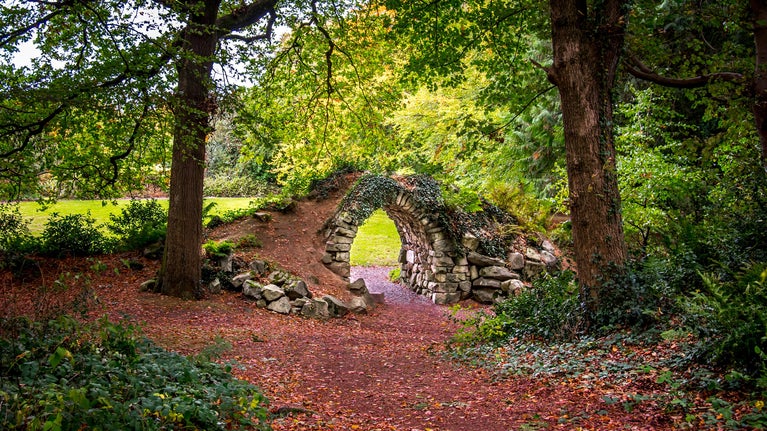
Discover more at Derrymore House
Find out how to get to Derrymore House, where to park, the things to see and do and more.

Derrymore House is a rare example of a late 18th century cottage orné in Northern Ireland, built as a summer retreat for politician Isaac Corry. Set within the wooded demesne at Bessbrook, its story spans political ambition, Quaker philanthropy, wartime defence and the resilience of a place shaped by conflict, religious and social shifts.
The land on which Derrymore sits was once part of the territory of the O’Hanlon clan, Lords of Orior. It passed through the hands of English planters, including the Bagenal and Needham families, before being acquired by the Corry family in the 18th century.
The house was built in the late 1770s by Isaac Corry (1753–1813), MP for Newry and later Chancellor of the Irish Exchequer. Designed to look rustic from the outside but refined within, Derrymore was probably the creation of renowned Irish landscape gardener John Sutherland. Its interiors were spacious and elegant, with large windows drawing the surrounding landscapes indoors.
With thatched roof and softly curved limewashed walls, Derrymore exemplified the Romantic Movement, including the appreciation of nature and beauty, social and cultural conscience, and a reaction against the Industrial Revolution.
Corry commissioned Sutherland to create a fashionable, miniature farmland setting for the cottage, surrounded by woodlands of oak, chestnut, pine and beech. Many of those trees still stand today.

Corry played a key role in the Act of Union, which in 1801 dissolved the Irish Parliament and brought Ireland into the United Kingdom. Though often claimed that the Act was drafted or signed at Derrymore, no direct evidence supports this claim. The myth likely emerged due to Corry’s support for the Union. He hoped the Union would secure Catholic emancipation and bring economic advantages to Ireland, promises that remained unfulfilled in his lifetime.
Corry sold Derrymore in 1810 and retired to Dublin, where he died in 1813. Earlier family history reveals links to global activities: Corry’s uncle Trevor Corry (1724–80), left a substantial fortune earned as a British consul in Danzig, Poland. His will refers to a Black servant named Pharoh, a reminder of Ireland’s connections to colonial and imperial systems.
In 1859, industrialist and Quaker philanthropist John Grubb Richardson (1815–90) purchased Derrymore. The opening of the nearby Craigmore Viaduct in 1852, linking Belfast and Dublin, further bolstered the booming Ulster linen trade in which Richardson played a key role. A pioneer of the linen industry and a member of the Society of Friends, Richardson had already established the model village of Bessbrook in 1845 for his workers. Run on the principle that a happy, but teetotal, workforce was a productive one, the village featured purpose-built housing, schools and other facilities.
Richardson let Derrymore out and built the Victorian villa known as the Woodhouse for his own family amongst the woods in the northern part of the demesne and added the estate’s entrance lodges. Introducing exotic trees and shrubs, he created informal woodland walks, transforming the rath, an early medieval settlement enclosure, into a garden that provided for the Quaker ideals of reflection, simplicity and moral improvement.

During the Second World War, Derrymore played a strategic role. In 1940, the Fife and Forfar Yeomanry were stationed nearby to guard against a possible German invasion from the south. In 1943, the U.S. Army Quartermaster Depot Q111-D took over. As in other parts of the U.S. military at the time, troops were segregated by race and Black American soldiers were housed in Nissen huts on the estate. The Nissen huts were removed in 1961, but their bases remain beneath the grass.
Derrymore was directly affected by the Troubles in the 1970s. The nearby linen mill in Bessbrook became a major British Army base, at one point the busiest military heliport in Europe. Isaac Corry’s association with the Act of Union made Derrymore a symbolic target, and between 1972 and 1979, multiple bombs were planted on the site. One bomb caused damage to the house. The house survived thanks in large part to the courage of caretaker Edmund Baillie, who carried the device away from the building. The house re-opened to the public in the late 1980s.
Derrymore House and part of the estate were gifted to the National Trust after the war by John S.W. Richardson, a descendant of John Grub Richardson. The Trust removed later building additions, rethatched the roof and re-opened the house to the public in 1957. Further land was gifted in 1985.
Since then, the Trust has maintained and enhanced Derrymore as a place for everyone to visit and enjoy. Together with several local and national partners, accessible footpaths, parking and toilets have been created, along with a children’s play area and dog-friendly facilities. The future will see this work continue to ensure that Derrymore is a sanctuary for the peaceful enjoyment of nature, beauty and history.

Find out how to get to Derrymore House, where to park, the things to see and do and more.
Visit Derrymore for picturesque walks through over 100 acres of parks and woodland, nature rambles, picnics and the historic 18th-century Derrymore House.

Derrymore, as the only parkland near the centre of Newry, is an excellent spot for walking with your canine companion. We want everyone to enjoy this beautiful spot, so we ask visitors coming with their dogs to follow these guidelines which are in-line with the Countryside Code.

Learn about people from the past, discover remarkable works of art and brush up on your knowledge of architecture and gardens.
